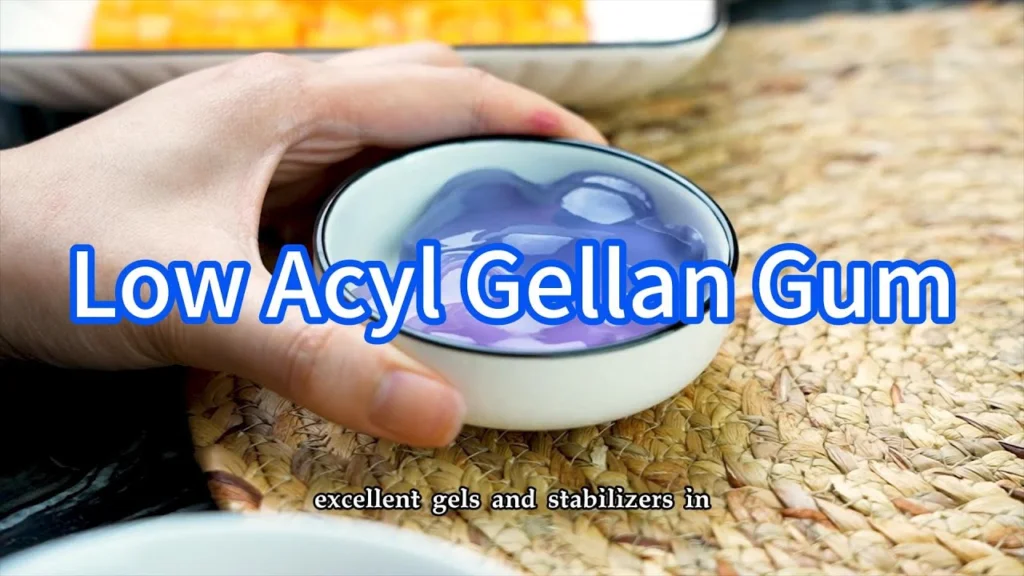When it comes to the fascinating world of gelling agents, low acyl gellan gum emerges as a star player. Its unique properties have made it a favorite among Gellan Gum manufacturers and suppliers alike. This versatile ingredient, produced by the brand Shine, stands out for its ability to create firm, elastic gels that are crystal clear. But what exactly makes low acyl gellan gum so special, and why is it preferred over its counterpart, high acyl gellan gum, in certain applications? Let’s dive into the chemistry, applications, and future trends of this remarkable substance.

Low acyl gellan gum, a polysaccharide secreted by the bacterium Sphingomonas elodea, is a shining example of innovation in the food and non-food industries. Its low acyl content means it has fewer acetyl groups attached to its carbohydrate backbone, which in turn influences its gelling properties. This characteristic makes it an invaluable tool for Gellan Gum manufacturers looking to produce high-quality gelling agents.
The magic of low acyl gellan gum lies in its molecular structure. This structure allows it to form gels that are not only robust and elastic but also thermoreversible. That means they can melt upon heating and solidify when cooled, a property highly prized by food scientists and chefs alike. Its ability to perform under a wide range of conditions makes it a go-to ingredient for Gellan Gum suppliers aiming to cater to a diverse market.
In the food industry, the role of low acyl gellan gum is nothing short of revolutionary. From jellies that jiggle with just the right consistency to dairy products that maintain their texture without separating, low acyl gellan gum works behind the scenes to ensure quality and stability. Plant-based alternatives also benefit from its gelling power, providing vegetarians and vegans with enjoyable textures in their diets. This versatility is why brands like Shine and other Gellan Gum manufacturers prioritize low acyl gellan gum in their product offerings.
The wonders of low acyl gellan gum extend far beyond the realm of food. In personal care products, it lends a silky, smooth texture to creams and lotions. Pharmaceutical applications include controlled-release drug formulations, where its gel matrix ensures precise delivery of active ingredients. Moreover, in biotechnology, low acyl gellan gum provides a supportive medium for cell cultures, demonstrating its critical role in advancements in medicine and research.
Understanding the differences between low and high acyl gellan gum is crucial for selecting the right type for specific applications. High acyl gellan gum forms softer, more elastic gels and is preferred in applications where a tender gel is desired. On the other hand, low acyl gellan gum, with its firm and brittle gel structure, is ideal when clarity and stability are paramount. This distinction is key for Gellan Gum suppliers and manufacturers in meeting the needs of a diverse clientele.
The future looks bright for low acyl gellan gum, with emerging markets and innovative applications on the horizon. One exciting area is 3D food printing, where its precise gelling properties can create complex, edible structures. Additionally, sustainable packaging solutions are exploring the use of biodegradable gels made from low acyl gellan gum, showcasing its potential in reducing plastic waste. As these trends develop, the role of Gellan Gum manufacturers and suppliers will be pivotal in shaping the future of food technology and environmental sustainability.
Introduction to Low Acyl Gellan Gum
Low Acyl Gellan Gum, a product that continues to shine in the world of gelling agents, stands out for its unparalleled ability to provide a unique texture and stability across a myriad of applications. Originating from a sophisticated fermentation process, this biopolymer has carved its niche in both the food and non-food sectors, thanks to its versatile properties. Unlike its counterpart, High Acyl Gellan Gum, which offers softer gels, Low Acyl Gellan Gum is celebrated for creating firm, brittle gels, a characteristic highly sought after by gellan gum manufacturers and gellan gum suppliers alike.

The journey of Low Acyl Gellan Gum from a laboratory curiosity to a staple in the food industry and beyond is a testament to its efficacy and the relentless pursuit of innovation by gellan gum suppliers. Its chemical composition, a deacylated form of gellan gum, allows it to form gels that are not just visually appealing but also capable of withstanding various processing conditions such as heat, acidity, and enzymatic breakdown. This makes it an indispensable ingredient in the formulation of products requiring precise texture and stability, ranging from the simplest jelly to the most sophisticated plant-based alternatives.
Understanding the distinction between Low Acyl and High Acyl Gellan Gum is crucial for manufacturers in selecting the right variant to achieve the desired textural properties in their products. While both types have their unique advantages, the choice largely depends on the specific requirements of the application, such as gel strength, clarity, and mouthfeel. This knowledge empowers gellan gum manufacturers to tailor their offerings to meet the exact needs of their clients, ensuring that the end products not only meet but exceed consumer expectations.
As the demand for cleaner labels and more natural products continues to grow, the role of Low Acyl Gellan Gum in the market is more pronounced than ever. Its ability to provide high-quality gelling without the need for high levels of sugar or synthetic additives aligns perfectly with the current trend towards healthier and more sustainable food options. This positions Low Acyl Gellan Gum as a key ingredient for the future, driving innovation in both existing and emerging markets. With ongoing research and development, the potential applications of this versatile polysaccharide are bound to expand, further solidifying its status as a shining example of ingenuity in the world of food science and beyond.
Chemical Composition and Properties
At the heart of the unique functionality of low acyl gellan gum lies its intricate chemical composition and properties. Manufactured by gellan gum suppliers, this biopolymer is a fermentation-derived product that has found its niche in a variety of applications, thanks to its versatile nature. Unlike its counterpart, high acyl gellan gum, which offers a more elastic gel, low acyl gellan gum provides a firm, brittle gel structure, making it a favorite among food technologists and product developers across the globe.
The molecular structure of low acyl gellan gum is what sets it apart. This polysaccharide consists of a tetrasaccharide repeating unit, comprising glucose, glucuronic acid, and rhamnose. The acyl groups, namely acetate and glycerate, are present in lower amounts in low acyl gellan gum compared to high acyl gellan gum. This difference in acyl content is pivotal, as it directly influences the gelation properties of the gum. Low acyl gellan gum forms gels in the presence of divalent cations (such as calcium or magnesium), which cross-link the polymer chains, resulting in a firm and brittle gel.
Shine, a leading brand among gellan gum manufacturers, leverages this unique property of low acyl gellan gum to produce gelling agents that are not only effective but also versatile. The ability of low acyl gellan gum to create clear, strong gels at low concentrations makes it an invaluable ingredient in the food industry, particularly in applications requiring precise texture and stability, such as jellies, desserts, and plant-based milk alternatives.
Furthermore, the thermal stability and fluid gel properties of low acyl gellan gum facilitate its use in more innovative applications. For instance, it can withstand high-temperature processing conditions, making it suitable for products that undergo sterilization or pasteurization. This characteristic, combined with its ability to form fluid gels that exhibit excellent suspension capabilities, positions low acyl gellan gum as a preferred choice among gellan gum suppliers for developing products that require stability over a wide range of temperatures.
In summary, the chemical composition and properties of low acyl gellan gum make it a standout ingredient in the arsenal of food technologists and product developers. Its ability to form firm, brittle gels, coupled with its thermal stability and suspension capabilities, opens up a realm of possibilities for creating innovative and high-quality products. As gellan gum manufacturers like Shine continue to explore and harness these properties, the potential applications of low acyl gellan gum are bound to expand, further solidifying its role as a key ingredient in the food industry and beyond.
Applications in the Food Industry
Low acyl gellan gum, a product that has significantly changed the landscape of the food industry, is celebrated for its remarkable gelling, thickening, and stabilizing properties. As food science evolves, the versatility of this ingredient, supplied by leading gellan gum manufacturers and gellan gum suppliers, has allowed food producers to innovate and improve the texture and stability of their products. One of the brands at the forefront of this innovation is Shine, which has consistently leveraged the unique properties of low acyl gellan gum to set new standards in food quality and consumer experience.

In the realm of jellies and jams, low acyl gellan gum has been a game-changer. It provides a clear, stable gel that’s perfect for capturing the vibrant colors and flavors that consumers love. But the applications don’t stop there. Dairy products, from yogurt to cheese, benefit immensely from low acyl gellan gum. It prevents separation and syneresis, ensuring that dairy goods maintain their desired consistency and mouthfeel throughout their shelf life. Moreover, in the burgeoning market of plant-based alternatives, low acyl gellan gum has emerged as a key ingredient. It helps mimic the texture and viscosity of animal-based products, making plant-based alternatives more appealing to a broader audience.
But why choose low acyl gellan gum over high acyl gellan gum for these applications? The answer lies in the texture. Low acyl gellan gum creates firm, brittle gels that are ideal for structured products like jellies and structured dairy alternatives. In contrast, high acyl gellan gum forms soft, elastic gels, better suited for applications requiring a more flexible texture. This distinction is crucial for food technologists and product developers working with gellan gum manufacturers and suppliers to achieve the precise textural attributes demanded by today’s discerning consumers.
The collaboration between Shine and other leading gellan gum suppliers has catalyzed the development of innovative food products. For instance, the role of low acyl gellan gum in stabilizing emulsions and suspensions has facilitated the creation of beverages with suspended particles, an increasingly popular trend in the beverage industry. This not only enhances the visual appeal of drinks but also contributes to a unique consumption experience, blending flavor, texture, and aesthetics in each sip.
Looking ahead, the potential applications of low acyl gellan gum in the food industry are boundless. As consumers continue to seek out novel food experiences and as manufacturers push the boundaries of what’s possible, ingredients like low acyl gellan gum will remain at the heart of innovation. With the support of Shine and other key players in the field, the journey of low acyl gellan gum from a niche ingredient to a staple in food science has only just begun.
Benefits in Non-Food Applications
Low Acyl Gellan Gum, a product that has revolutionized not only the food industry but also various non-food sectors, stands out for its versatility and efficiency. The benefits of Low Acyl Gellan Gum in non-food applications are vast and varied, contributing significantly to the advancement of numerous industries. From personal care products to pharmaceuticals and even into the realms of biotechnology, the impact of this polysaccharide, produced by reputable Gellan Gum manufacturers and suppliers, is profound.
In the personal care industry, the hydration and film-forming properties of Low Acyl Gellan Gum have been utilized to improve the texture and stability of products such as lotions, gels, and creams. The ability of this ingredient to form clear, smooth gels at low concentrations makes it an ideal choice for formulating products that require a luxurious feel and appearance. The brand Shine, recognized among leading Gellan Gum suppliers, has been at the forefront of incorporating Low Acyl Gellan Gum into cosmetic products, enhancing their appeal and functionality.

Pharmaceutical applications of Low Acyl Gellan Gum are equally impressive. Its use in controlled-release drug formulations exemplifies the polysaccharide’s utility in delivering medication effectively. By forming gels that can encapsulate active pharmaceutical ingredients, Low Acyl Gellan Gum ensures a sustained release of drugs, improving patient compliance and treatment outcomes. High Acyl Gellan Gum is also used in this sector, but the selection between the two types depends on the specific requirements of the formulation, such as gel strength and viscosity.
Furthermore, the biotechnology industry benefits from the unique properties of Low Acyl Gellan Gum. Its role in tissue engineering and regenerative medicine, particularly in the creation of scaffolds that support the growth and proliferation of cells, is noteworthy. The gel’s ability to mimic the extracellular matrix provides an optimal environment for cell culture, facilitating research and development in this cutting-edge field.
Emerging applications of Low Acyl Gellan Gum in non-food sectors also include its use in sustainable packaging solutions. Innovations in this area are exploring the potential of biodegradable films and coatings derived from Low Acyl Gellan Gum, which could significantly reduce the environmental impact of packaging materials.
The versatility and functionality of Low Acyl Gellan Gum, as demonstrated across a wide range of non-food applications, underscore the importance of choosing high-quality products from trusted Gellan Gum manufacturers and suppliers. The commitment of brands like Shine to providing superior Gellan Gum variants ensures that industries can leverage the full potential of this remarkable polysaccharide, driving innovation and enhancing the quality of non-food products.
Comparison with High Acyl Gellan Gum
When it comes to the world of gellan gum, the distinction between low acyl and high acyl varieties is crucial for manufacturers and suppliers to understand. Both types offer unique properties that make them suitable for different applications, but knowing the nuances can help in making the right choice for your product. Let’s delve into the comparison, keeping an eye on how Shine, a leading brand in the gellan gum industry, leverages these differences to cater to diverse market needs.

Low acyl gellan gum, as we’ve explored, is known for its ability to form firm, non-elastic gels. This characteristic is particularly valued in applications where clarity and gel strength are paramount. On the other hand, high acyl gellan gum creates soft, elastic gels, which are preferred in applications requiring a more flexible texture. This fundamental difference in gel texture plays a significant role in determining which type of gellan gum is suitable for a specific application.
From the perspective of gellan gum manufacturers and suppliers, understanding the target market’s needs is essential. For instance, Shine, being at the forefront of innovation in the gellan gum space, offers both low acyl and high acyl gellan gum to meet the varying demands of the food, pharmaceutical, and biotechnology industries. The choice between low and high acyl types often comes down to the desired consistency and texture of the final product.
Moreover, the solubility and dispersibility of these two types of gellan gum vary, which can influence their use in different manufacturing processes. Low acyl gellan gum requires higher temperatures to dissolve, whereas high acyl gellan gum can disperse and hydrate at lower temperatures, making it more versatile in applications with sensitive temperature requirements.
Another aspect where low acyl and high acyl gellan gum differ is in their interaction with ions. Low acyl gellan gum forms gels in the presence of cations, which can be advantageous in creating structured products. High acyl gellan gum, however, is less dependent on ions, allowing for more flexibility in formulations that do not have controlled ionic strengths.
Shine, along with other gellan gum manufacturers and suppliers, emphasizes the importance of choosing the right type of gellan gum based on the application’s specific requirements. Whether it’s for the stability and texture of plant-based milk alternatives, the clarity and firmness of jellies, or the flexibility needed in personal care products, the choice between low acyl and high acyl gellan gum can significantly impact the product’s success.
In conclusion, the comparison between low acyl and high acyl gellan gum highlights the importance of understanding each type’s unique properties. For industry leaders like Shine, offering both varieties ensures that clients have access to the right gellan gum to meet their product’s needs. As the demand for versatile and high-quality gelling agents continues to grow, the knowledge of the differences between low and high acyl gellan gum becomes increasingly valuable for manufacturers and suppliers alike.
Future Trends and Innovations
The world of food science and material engineering is always on the brink of the next big breakthrough, and low acyl gellan gum is at the forefront of this innovative wave. As we dive into the future trends and innovations surrounding this versatile ingredient, the spotlight shines on its potential to revolutionize not just the food industry but also non-food sectors in unprecedented ways. Shine, a leading name among gellan gum manufacturers, is pioneering the research and development in this area, setting the stage for a future where low acyl gellan gum plays a pivotal role in sustainable solutions and advanced technology applications.
One of the most exciting prospects for low acyl gellan gum lies in the realm of 3D food printing. This technology promises to transform the way we think about food preparation, customization, and presentation. The unique gelling properties of low acyl gellan gum make it an ideal candidate for creating precise, stable structures that can be printed layer by layer to produce complex edible items. This not only opens up new avenues for culinary creativity but also has the potential to address food sustainability challenges by optimizing ingredient use and reducing waste.

Another area where low acyl gellan gum is set to make a significant impact is in the development of sustainable packaging solutions. As the world grapples with the environmental consequences of plastic waste, gellan gum manufacturers and suppliers are exploring biodegradable alternatives that can safely decompose without harming the planet. Low acyl gellan gum, with its ability to form strong, flexible gels, offers a promising base material for creating eco-friendly packaging films and coatings that could one day replace conventional plastics in many applications.
In addition to these innovative uses, the comparison between low and high acyl gellan gum continues to be a topic of interest for researchers and industry professionals alike. Understanding the nuanced differences in gel strength and texture provided by each type allows for more targeted applications, ensuring that products meet the exact needs of consumers. Whether it’s in the food industry, where the demand for plant-based alternatives and texture-modified foods is growing, or in pharmaceuticals, where precise gel formulations are crucial, the choice between low and high acyl gellan gum is more relevant than ever.
As we look to the future, the collaboration between gellan gum manufacturers, suppliers, and innovators across various industries is vital. Shine, along with other key players in the field, is committed to pushing the boundaries of what’s possible with low acyl gellan gum. By fostering a culture of innovation and sustainability, they are not just predicting the future trends; they are actively shaping them, ensuring that low acyl gellan gum continues to be a shining example of versatility and functionality in the world of modern science and technology.
Frequently Asked Questions
- What is Low Acyl Gellan Gum?Low acyl gellan gum is a refined polysaccharide that’s used as a gelling agent in both food and non-food applications. It’s known for its excellent gelling, thickening, and stabilizing properties, making it a go-to ingredient for improving texture and stability in a wide range of products.
- How Does Low Acyl Gellan Gum Differ from High Acyl Gellan Gum?The main difference between low and high acyl gellan gum lies in their gelling properties and texture. Low acyl gellan gum forms firm, brittle gels, whereas high acyl gellan gum creates soft, elastic gels. This distinction is crucial for manufacturers when choosing the right type of gellan gum to achieve the desired texture in their products.
- What Are the Applications of Low Acyl Gellan Gum in the Food Industry?In the food industry, low acyl gellan gum is widely used to enhance the texture and stability of products like jellies, dairy items, and plant-based alternatives. Its ability to create a clear, strong gel is particularly valued in the production of jellies and other structured foods.
- Can Low Acyl Gellan Gum Be Used in Non-Food Applications?Absolutely! Beyond its uses in the food industry, low acyl gellan gum finds applications in personal care products, pharmaceuticals, and even in biotechnology. Its texturizing and stabilizing benefits are invaluable in creating consistent and desirable textures in a variety of non-food products.
- What Are the Benefits of Using Low Acyl Gellan Gum?Low acyl gellan gum offers numerous benefits, including superior gelling strength, excellent thermal stability, and the ability to form gels at a wide range of temperatures. It also contributes to the longevity and quality of products by improving their texture and stability over time.
- How Does Low Acyl Gellan Gum Contribute to Future Trends and Innovations?Low acyl gellan gum is at the forefront of innovation in areas like 3D food printing and sustainable packaging. Its unique properties enable the creation of intricate shapes and textures in 3D printed food, and its biodegradability presents a promising avenue for developing eco-friendly packaging solutions.
